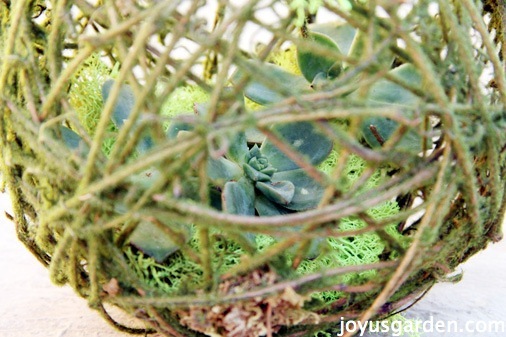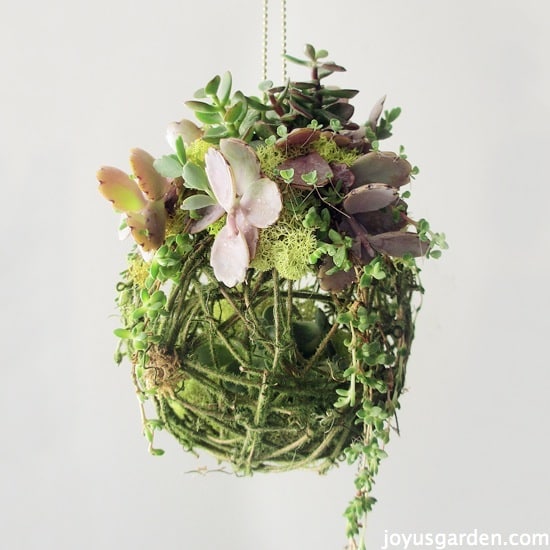制作多肉亲吻球的不同方法


接吻球就像一年四季都有的槲寄生,如果你看到了,就撅起嘴来!这一古老的传统以不同的装饰和点缀方式重新焕发了生机。 它们不再只是圣诞节的专属了。 我的花园里种满了多肉植物,可以用来做我的植物手工项目,但你可能没有。 今天,我将向你展示另一种制作多肉接吻球的方法,只需使用扦插一些多肉植物。
我相信你一定见过被多肉植物完全覆盖的顶球。 它们可以是同一种类型,也可以是不同颜色和质地的混合体。 当我在一家兰花种植者的温室里看到这个被苔藓覆盖的藤球时,它简直就像跳进了我的购物篮。 这是一个类似的球,但没有苔藓覆盖。
我很喜欢这个球的原貌,所以我不想把它完全盖住。 我想让它的大部分露出来。
我剪去了一些藤蔓,这样就能看到球内的更多东西了。 我小心翼翼地将 3 棵白芍的叶子向内折叠,然后将它们从藤蔓结构的最大开口处缓缓移到驯鹿苔藓床的顶部。 它们已经长成了 "猫头鹰",所以我用一根长而尖的花桩将它们竖起来并固定好。 您可以用筷子或编织针将它们固定好。这。

这是腌制驯鹿苔藓的特写。 我用的是春天的绿色,但如果你不喜欢,也可以选择其他颜色。 需要提醒的是:这种苔藓很好用,但刚打开包装时会有异味。 不过,一旦接触到外界,异味就会消失。

我把衣架固定在球的顶部。 为此,我用了一英尺长的球链,这是我在当地五金店买的。 我把驯鹿苔藓团成一团,然后用热熔胶把它们粘在球的四周。

我剪下了一小片微型玉石植物和薰衣草扇贝,粘在最顶端。 这个多肉接吻球是一个多月前做的。 如果你仔细观察,就会发现薰衣草扇贝叶片的顶端出现了一些小植株。 你看到的是一种耐寒的小冰草 Delosperma,它从两侧垂下来。
See_also: 地球之星植物护理:种植双叶隐花属植物这个球现在成了我家前廊的装饰品,无论是悬挂还是放在桌子上,它都能为您的家增添一抹自然的气息!
看看我是怎么做的
更多的多肉植物项目
装饰多肉植物的鸟巢
多肉花篮;鸟澡盆插花
See_also: 有机花卉园艺:须知事项多汁藤蔓花环
小贴士:如果你不像我一样有一个种满多肉植物的花园,那么你可以在 Etsy、eBay 或亚马逊上购买插条。 这样一个项目不需要那么多插条。
本文章可能包含联盟链接。 您可以在此阅读我们的政策。 您购买产品的成本不会增加,但 Joy Us garden 会收取少量佣金。 感谢您帮助我们传播信息 & 让世界变得更美丽!

